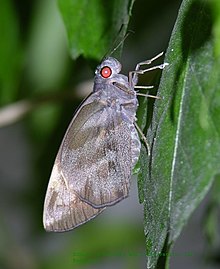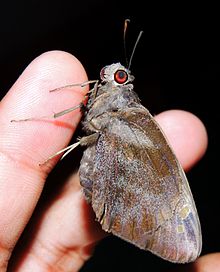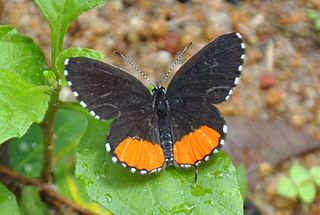
Talicada nyseus, the red Pierrot, is a small but striking butterfly found in the Indian subcontinent and South-East Asia belonging to the lycaenids, or blues family. The red Pierrots, often found perching on its larva host plant, Kalanchoe, are usually noticed due to their striking patterns and colors.

Elymnias hypermnestra, the common palmfly, is a species of satyrine butterfly found in South and Southeast Asia.

Ancistroides folus, the grass demon, is a small but prominent butterfly found in India & Nepal that belongs to the skipper family, Hesperiidae. It is regarded as an occasional pest of ginger and turmeric plants.

Graphium agamemnon, the tailed jay, is a predominantly green and black tropical butterfly that belongs to the swallowtail family. The butterfly is also called the green-spotted triangle, tailed green jay, or green triangle. It is a common, non-threatened species native to Nepal, India, Sri Lanka through Southeast Asia and Australia. Several geographic races are recognized. The species was first described by Carl Linnaeus in his 1758 10th edition of Systema Naturae.
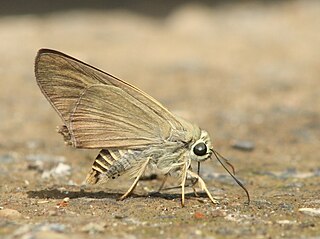
Badamia exclamationis, commonly known as the brown awl or narrow-winged awl, is a butterfly belonging to the family Hesperiidae. It is found in south and southeast Asia, Australia, and Oceania.

Caltoris canaraica, the Kanara swift, is a butterfly belonging to the family Hesperiidae.

Halpe porus, commonly known as Moore's ace, is a species of butterfly in the family Hesperiidae, found in India.

Matapa aria, the common redeye, is a species of butterfly belonging to the family Hesperiidae. It is found in India and Southeast Asia.
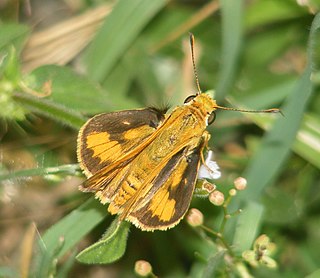
Telicota colon, commonly known as the pale palm dart or common palm dart, is a species of butterfly in the family Hesperiidae. It is found from India to Australia.

Spialia galba, the Indian grizzled skipper, is a hesperiid butterfly which is found in South Asia and parts of Southeast Asia.
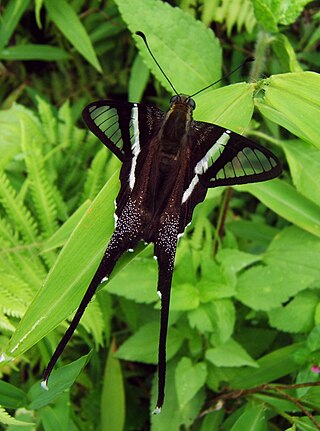
Lamproptera curius, the white dragontail, is a species of swallowtail butterfly native to parts of South Asia and Southeast Asia where it is common. It belongs to the dragontails genus, Lamproptera, of the swallowtail family, Papilionidae.

Appias lalage, the spot puffin, is a small butterfly of the family Pieridae, that is, the yellows and whites, which is found in India, Indochina and Hainan.

Appias indra, the plain puffin, is a small butterfly of the family Pieridae, that is, the yellows and whites, which is found in south and southeast Asia.
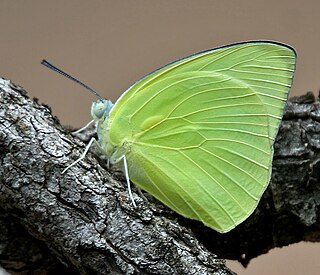
Catopsilia pomona, the common emigrant or lemon emigrant, is a medium-sized pierid butterfly found in Asia and parts of Australia. The species gets its name from its habit of migration. Some early authors considered them as two distinct species Catopsilia crocale and Catopsilia pomona.

Jamides celeno, the common cerulean, is a small butterfly found in Indomalayan realm belonging to the lycaenids or blues family. The species was first described by Pieter Cramer in 1775.

Junonia hierta, the yellow pansy, is a species of nymphalid butterfly found in the Palaeotropics. It is usually seen in open scrub and grassland habitats.

Neptis jumbah, the chestnut-streaked sailer, is a species of nymphalid butterfly found in South Asia.

Bibasis oedipodea, the branded orange awlet, is a species of hesperid butterfly found in South Asia and Southeast Asia. The butterfly was reassigned to the genus Burara by Vane-Wright and de Jong (2003) and is considered by them to be Burara oedipodea.

Gangara lebadea, commonly known as the banded redeye, is a species of hesperid butterfly found in Southeast Asia.

Eudocima phalonia, the common fruit-piercing moth, is a fruit piercing moth of the family Erebidae. The species was first described by Carl Linnaeus in his 1763 Centuria Insectorum. It is found in large parts of the tropics, mainly in Asia, Africa and Australia but introduced into other areas such as Hawaii, New Zealand and the Society Islands. It is one of major fruit pests in the world.
